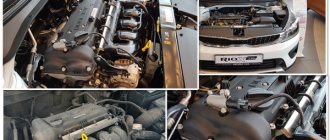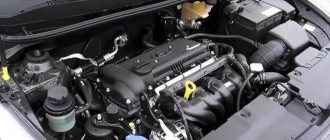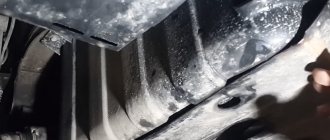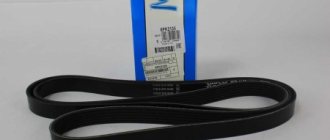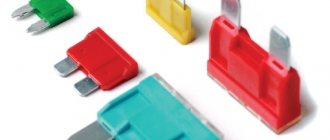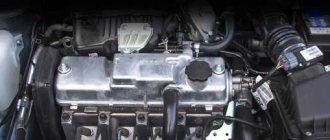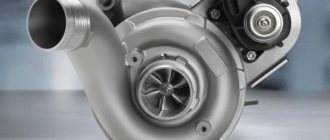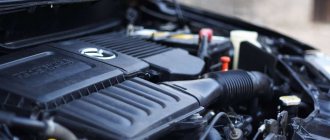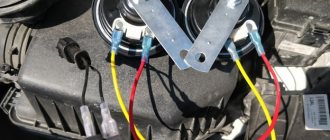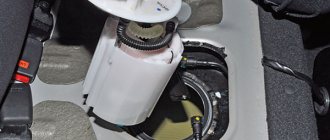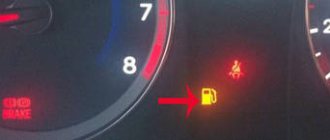Service life and repair of engine and gearbox for Hyundai Solaris (Hyundai Solaris)
Since 2010, Hyundai Solaris has been equipped with 1.4 and 1.6 liter gasoline engines. At first it was G4FA and G4FC, later G4LC. Their power ranges from 100 to 123 horsepower. The engines operate in tandem with a manual or automatic transmission. The first manual transmission on Solaris, labeled M5CF1, had 5 stages and was based on a two-shaft design; a few years after the start of production, the six-speed manual M6CF1 became available. As for the automatic transmission, the Korean manufacturer initially used the A4CF1 four-speed automatic transmission. After the 2014 restyling, a six-speed automatic was developed for versions with a 1.6-liter engine, but the A4CF1 gearbox is still available for the Hyundai Solaris with a 1.4-liter engine.
Manual and automatic transmissions Hyundai Solaris
For Hyundai Solaris, classic mechanics and automatic are available. The car was equipped with two different automatic transmissions: four- and six-speed. Moreover, the six-speed gearbox labeled A6GF1 is more economical, pleases with smooth operation, but disappoints with a mediocre response to pressing the gas pedal. The A6GF1 holds 7.3 to 7.8 liters of ATF.
Although the plant does not provide for changing the oil in the automatic transmission, this should be done every 80–100 thousand km. After all, the A6GF1 gearbox is sensitive to the quality and pressure of the oil, the integrity of the seals and gaskets. If you neglect maintenance, critical wear and failure of solenoids and clutches are likely. The RVS Master Transmission Atr7 additive will help restore the automatic gearbox and prevent its wear.
Five- and six-speed manual transmissions of the Hyundai Solaris are quite reliable, which is confirmed by the experience of their operation on the Elantra and other Korean models. Among the factory shortcomings of the five-speed unit are increased noise and a hum when reversing. The defect appeared on cars manufactured before 2012.
In manual transmissions, we recommend changing the oil every 50–60 thousand km. And to extend the life of the box, use RVS Master Transmission Tr3. Thanks to the additive, it will be possible to extend the life of parts, compensate for wear on friction surfaces, achieve easier shifting, reduce transmission noise and restore gears.
Source
Technical features of Hyundai Solaris engines
The Gamma series of engines, developed for the Hyundai Solaris and other models of the concern, replaced the Alpha series and has the following characteristic features:
- The cylinder block is cast from aluminum, the lightweight design has high rigidity. To prevent the cylinder from being abraded by the piston, a thin cast iron sleeve is used, which is fused into the part. This arrangement allows you to reduce the weight of the motor, achieve quick warm-up and effective cooling of the power plant. At the same time, fuel consumption decreases.
- The manifolds are designed based on the reverse design: the catalyst and exhaust manifold are located between the engine shield and the engine itself, while the intake manifold is located in front. This scheme made it possible to increase power, simplify maintenance and repair of the injection system.
- The timing mechanism drive uses a chain, the stretching of which is prevented by hydraulic tensioners.
- A system has been introduced that changes the valve timing, which improves the car's torque.
- There are no hydraulic compensators.
- Attachable units, in particular the generator, power steering pump, and air conditioning compressor, are located more intelligently than in Alpha series engines.
Structurally, the G4FC and G4FA motors, despite their different volumes, are similar. A chain is used to drive the gas distribution mechanism, which runs 150–180 thousand km without problems. It is recommended to adjust the valves every 100 thousand km. These Solaris engines are unpretentious and economical. Although they are quite noisy, especially until they warm up.
The lifespan of the Solaris engine depends on standard factors: quality of service, driving style, compliance with operating standards. The manufacturer issues a car warranty of 150 thousand km. But Hyundai Solaris power units run 200–300 thousand km without problems. And what after? Afterwards repairs are required. And since the block is made of aluminum, it can be considered “disposable”, that is, after the cylinders wear out, it must be replaced.
There are workshops in Russia that have developed their own restoration methods, but the fact remains: there are no strictly verified factory repair technologies; engineers created a lightweight, high-tech cylinder block, sacrificing its maintainability.
Then what do motorists do? They bore blocks, grind crankshafts and cylinder heads, remove and replace cast iron liners. But the difficulty is that the wall of the sleeve is very thin, and it itself is “filled” with aluminum - fused into the block. And due to the fact that the strength, corrosion resistance, and hardness of aluminum and cast iron are different, it is necessary to carry out other, more subtle repair operations, which not every craftsman can do.
Therefore, it makes sense to strictly observe maintenance standards, change the oil and oil filter every 7.5–10 thousand km (the manufacturer recommends an oil with a viscosity of 5w20 or 5w30), and also additionally use a composition for in-place repairs and flushing, which will extend the life of the power unit. It is advisable to do treatment with a repair and restoration composition before characteristic signs of Solaris engine malfunctions appear:
- Compression drop.
- Engine vibration and speed surges.
- Increased oil consumption.
- Loud noise due to wear of the crankshaft and elements of the cylinder-piston group.
Source
Pros, cons and resource
I'll start with the resource - this will be the first advantage . The manufacturer gives about 200,000 km, but now there are cars since 2010 that have already covered 500 - 600,000 km and you know, the engines work, no matter what (no matter how much they are scolded).
Indeed, the units are problem-free , and they often do not run on the best 92 gasoline. It is worth noting the convenient location, everything can be reached and easily replaced (spark plugs, air filter), intake and exhaust manifolds, engine mounts. Short inlet, and this is not unimportant (the shorter it is, the less pumping losses due to suction). Also, there is not such a large volume of plastic as now in many modern engines. The main thing is to maintain it on time (I still recommend you change the oil every 10,000 km), use high-quality synthetics (there is still a phase shifter and a chain tensioner), and fill in 95 gasoline.
On the downsides (although these are not downsides, but my recommendations). The noisy operation of the fuel injectors is not fatal, but it is a fact (it does not seem to be a chattering chain). There are no hydraulic compensators (there are ordinary pushers) they need to be changed (by selecting new ones according to height) approximately once every 100,000 km. It is also advisable to replace the chain mechanism, and the timing chain itself, up to 150,000 km. Sometimes there are problems with the catalyst (it can simply crumble), crumbs from it get into the cylinders and can very quickly kill the engine. The problem is not widespread, but it happens, as dealers assure, from low-quality fuel, so refuel at normal gas stations
If we sum up the G4FA or G4FC, G4FG motor, then they really now have a great resource. As one mechanic told me, “reliable as a hammer and that not all Japanese walk like that now.” THIS IS WHY many taxi companies love them so much.
Engine RIO/SOLARIS 1.6 G4FC 123 hp. Reliability “Korean style”
Today I’ll tell you about the cool “Korean” G4FC engine on Solaris and Rio cars. Why in quotes? It’s just that this engine is assembled in Beijing (China) at the Beijing Hyundai Motor Co. plant. There they assemble the gearbox for it and the whole thing goes to the plant in St. Petersburg, where Rio and Solaris are assembled. There is nothing bad about this; the engine life is declared by the manufacturer for the entire service life of the car - 180 t.km. or 10 years, about which there is a corresponding entry in the service book (see below)
In fact, these engines run much longer; mileages of 300-400 t.km are common.
In 2021, these engines will begin to be assembled in Russia, the plant is already under construction. Then it will be possible to compare the quality of our assembly and the Chinese one.
The engine itself is simple and reliable, which is becoming less and less common these days. The timing drive is chain. Reliable distributed fuel injection. By modern standards, the engine is “cold”, that is, it has a low operating temperature. Due to the high temperature, the rings can quickly coke and the engine oil can “age” quickly. Does not have a problematic heat exchanger, or a plastic thermostat, or a plastic valve cover with a built-in crankcase ventilation valve. It is as simple as a hammer with a metal handle. It does not cause problems for owners and does not burden them with expensive maintenance. You can really say about it “I only change consumables.”
Hyundai Solaris: engines, engine life and operation
Hyundai Solaris and KIA Rio are among the most popular and sought-after models on the market. In general, the 1.4 liter and 1.6 liter naturally aspirated engines on Solaris or Rio are considered modern and reliable.
In practice, the average engine life is about 200-250 thousand km. and more. However, it is necessary to separately take into account the nuances, since the Solaris engine on cars of different years of production can be represented by the following version:
- Gamma (displacement 1.4-1.6);
- Kappa (displacement 1.4);
- updated version of Gamma (Gamma II).
Moreover, even taking into account the general similarity in design, there are certain differences between the motors. Read more in our article.
How is an engine overhaul done on a Solaris?
The high degree of wear when two aluminum parts come into contact (piston and cylinder walls) forces engineers to come up with new means to prevent rapid wear.
Often a cast iron liner is pressed into the cylinder block , which wears out much more slowly than aluminum. But there are other methods, for example, on expensive high-performance engines, the cylinder walls are chemically treated with nickel and silicon carbide to obtain a durable wear-resistant surface, or the cylinder mirror is etched and a surface with a high silicon content is obtained.
What engine can be installed on the Hyundai Solaris?
To understand which Solaris engine is under the hood, it should be noted that the Hyundai Solaris engines of the first years of production (2010-16) were represented exclusively by Gamma engines with a displacement of 1.4 liters and 107 hp. and 1.6 liters for 123 hp. By the way, these same engines can be found on other models of the Korean manufacturer: Hyundai Elantra, Kia Ceed, etc.
Then in 2021, the following engines began to be installed on the Hyundai Solaris and Kia RIO:
- KAPPA engine with a displacement of 1.4 liters and a power of 100 hp.
- modernized GAMMA power unit with a displacement of 1.6 liters and 123 hp.
Engine Hyundai Solaris GAMMA
The first versions of Solaris were equipped with G4FA and G4FC engines. These engines were produced at the Hyundai plant in China. At the same time, it is a mistake to believe that the motor is Chinese, Chinese designs are used, etc.
In fact, the Korean plant is located outside of China (by analogy with other major global auto manufacturers), while the Korean corporation strictly controls product quality.
As for the main features of the Gamma engine:
- The engine is in-line, 4-cylinder, 16-valve. The cylinder block is aluminum with thin-walled dry cast iron liners. If necessary, today these motors are qualitatively repaired by relining the block. The engine also received lightweight pistons and a durable cast-iron crankshaft.
- The gas distribution mechanism has a chain drive with a hydraulic chain tensioner. The design uses two camshafts, 4 valves per cylinder, and one phase shifter is installed on the intake timing shaft. There are no hydraulic compensators. Thermal valve clearances must be adjusted every 90 thousand km, but in practice the adjustment is carried out earlier. You should also check the clearances more often if the engine is running on gas.
As for motor oil, you need to fill in “synthetic” 5W-30 or 5W-40. Officially, an oil change is required every 15 thousand km, while the declared resource is 200 thousand km. mileage However, in practice, if you change the lubricant more often and properly operate and maintain the engine, the engine is quite capable of traveling 300 thousand km or more. mileage
Gamma II engine
Since 2021, Solaris and Rio began to install the G4FG engine, which is also unofficially called Gamma II. So, this 1.6 liter engine moved to the younger models from the older Hyundai Elantra, Kia Sid, etc.
Moreover, this engine on higher-class models had a power of about 130 hp, but on Solaris its power was artificially (software) limited to 123 hp. If necessary, chipping the ECU with the original firmware will allow you to return the standard power.
In general, the entire line of GAMMA motors:
- volume 1.4 liters G4FA with one phase shifter (installed until 2017);
- volume 1.6 liters G4FC with one phase shifter (installed until 2017);
- volume 1.6 liters G4FG with two phase shifters (installed from 2017 to the present);
Note that also in 2021, the 1.4 liter Gamma G4FA engine with one phase shifter was replaced with another power unit. On Solaris, the new engine was designated KAPPA 1.4 G4LC.
Increased service life of 1.4, 1.6 engine
Power units 1.4 and 1.6 not only have good technical characteristics, but also have a high level of reliability. During the operation of the sedan, the owners do not have any major complaints about the operation of the engine. The service life of the engine directly depends on the operating conditions of the car and timely maintenance. Therefore, the figure of 180 thousand km can in practice vary up and down. It all depends on the car owner himself. You can increase the engine life of Hyundai Solaris in the following ways:
- Refuel your car only at proven and certified gas stations. This way the driver can be sure that the car is “powered” by normal fuel;
- The use of certified oil, which is recommended by the car manufacturer itself, also has a significant impact on the duration of trouble-free operation of the sedan;
- You should not force the power unit to wear out. Operating the engine at its limit only contributes to an increase in the level of wear of parts, which in turn provokes premature breakdowns.
Thus, the service life of the Hyundai Solaris power unit depends only on the owner. Timely maintenance of the car and proper care increases its service life significantly. Engines with a displacement of 1.4 and 1.6 liters are distinguished by their reliability and unique design, which increases the reliability of key engine parts. In practice, it has been verified that both of these engines are capable of covering more than 300 thousand kilometers before the first serious breakdown occurs.
Hello everyone. Walking around the expanses of the drive, I often see posts such as help with choosing a motor, what are the weak points of this motor, what can be done to increase the power? So, I came across a source and I want to share with you, maybe it will help someone decide on the engine, for some it will be a hint about weaknesses, and for others it will find an idea for tuning.
Let's start with the younger 1.4 engine with the index G4FA
Kia-Hyundai G4FA engine Characteristics of the G4FA engine Manufactured by Beijing Hyundai Motor Co. Engine brand G4FA Years of production – (2010 – present time) Cylinder block material – aluminum Power system – injector Type – in-line Number of cylinders – 4 Valves per cylinder – 4 Piston stroke – 75 mm Cylinder diameter – 77 mm Compression ratio – 10.5 Volume engine – 1394 cm3 Engine power – 107-109 hp. /6300 rpm Torque - 135 Nm / 5000 rpm Fuel - 92 Environmental standards - Euro 4 Engine weight - n.d. Fuel consumption - city 7.8 l. | track 5.0 l. | mixed 6.0 l/100 km Oil consumption - up to 1 l/1000 km (in severe conditions) Engine oil Solaris/Rio g4fa: 5W-30 How much oil is in the Rio/Solaris engine: 3.3 l. When replacing, pour about 3 liters. An oil change is carried out every 15,000 km (preferably 7,500 km) Operating temperature of the Solaris/Rio engine:
90 deg. Solaris/Rio engine life: 1. According to the plant – 180 thousand km. 2. In practice – n.d.
TUNING Potential – 200+ hp. Without loss of resource - 110-115 hp.
Malfunctions and repairs of the Solaris/Rio G4FA 1.4 l engine.
The G4FA engine belongs to the new Gamma series, which was released in 2010 and replaced the outdated Alpha engines. The Gamma includes two engines, a 1.4 liter G4FA and a 1.6 liter. G4FC, assembled on one cylinder block, but we will focus on the youngest representative of the range. Unlike the old Alpha series engines, the G4FA engine uses a timing chain with tensioners, which does not require maintenance during its official life. The Solaris/Rio 1.4 engine is equipped with a variable valve timing system, but only on the intake shaft, in addition, the G4FA engine does not have hydraulic compensators, so once every 95,000 km you need to adjust the valve clearances by replacing the pushers, the procedure is not cheap, but you should not neglect it, otherwise it will will entail even greater problems in the form of noise, tripping, burnouts, etc.
Many people are interested in the manufacturer of the Hyundai Solaris/Kia Rio engine, so it is produced at the Beijing Hyundai Motor Company, and the engine is Chinese, but don’t rush to shout “garbage/fall apart/junk...”, let’s take a clear look at the shortcomings and main malfunctions of the G4FA engine, and then we will conclude: 1. A popular and disturbing problem for the masses is a knocking sound in a Rio or Solaris engine, if your knocking disappears with warming up, then most likely it is the timing chain that is making noise (in 90% of cases this is the case) and there is nothing to worry about if But you can hear it even when it’s hot, then the problem may be in unadjusted valves; they can be adjusted incorrectly at the factory. Contact the service and have it adjusted. 2. Noise of a nature reminiscent of clicks, clattering, chirping and other similar sounds, this is the normal operation of the injectors and they don’t know any other way :) 3. Oil leaks do not happen often, however, the valve cover gasket is not ideal and traces of oil are signs of this , change the gasket and drive on without any problems. 4. The speed fluctuates, uneven operation of the Rio/Solaris engine is not a rare problem, it is usually solved by cleaning the throttle valve, if that does not help, then updating the firmware. 5. Vibrations at idle speed, the cause of this phenomenon is a dirty throttle valve or spark plugs, clean the throttle valve, change the spark plugs and enjoy the pleasant operation of the engine. In case of strong vibrations, look at the engine mounts. 6. Vibrations at medium speeds also bother owners (
Features of the 1.4 liter KAPPA engine
In fact, the new 1.4 liter Solaris G4LC engine is also a continuation of the Gamma engine line. Previously, this engine was installed on the Hyundai i30 and Kia Sid. By analogy with the 1.6 liter Gamma 2, the power for Solaris is also artificially reduced to 100 hp. At the same time, on the i30 such engines normally produce about 110 hp, which can be “returned” on the Solaris or Rio using chip tuning.
These motors are assembled in Korea, the design is practically no different from GAMMA motors. The timing belt is traditionally chain, and the mechanism already has two phase shifters. The only major difference is that KAPPA has been lighter by 14 kg. The pistons also became even lighter than on the previous version, the crankshaft received a more tonic journal.
In any case, today it is impossible to say unambiguously how much such relief affected the engine’s service life. The resource declared by the manufacturer is the same 200 thousand km. However, theoretically, “thin” and light motors last less and are less maintainable, which is also often confirmed in practice.
Hyundai Solaris engines: which engine to choose
As you can see, on the Hyundai Solaris the 1.4 or 1.6 liter engine can be conditionally represented by the old generation (Gamma engines until 2017) or the new Kappa and Gamma II power units.
At the same time, engines after 2021 cannot be considered new, since they were previously installed on C-class models (Elantra, Sid, etc.), and then they were derated for tax and began to be installed on Solaris.
For more modern versions (Gamma II and Kappa) there are fewer statistics, but today you can also find many serviceable copies with mileages of about 200-250 thousand km. Of course, these engines are a little more complicated than their predecessors (two phase shifters, a noticeably lighter version of the 1.4 liter Kappa), however, with proper care and maintenance, the engines also have a good chance of lasting at least 350-400 thousand km.
It turns out that even if the new engines on Solaris or Rio turn out to have less resource, their safety margin is still sufficient to talk about the overall reliability of these power units. This means that you can safely take Solaris with any engine.
How long does the engine run on Solaris?
The factory resource of the Hyundai Solaris engine is 180 thousand km. This is exactly the distance a car can travel without serious breakdowns. In practice, the sedan is capable of traveling more than 300 thousand kilometers. The engine with a displacement of 1.6 liters is equipped with a fuel injection distribution system and is part of the series of so-called Gamma power units.
During numerous tests, this motor has demonstrated the lowest level of wear of components. The manufacturer managed to achieve this by implementing non-standard solutions in the motor design. For example, instead of pressed liners, fused ones are used, and the piston is also equipped with oil cooling at the bottom.
As for gas distribution, the DOHC system is involved. The Hyundai Solaris has a universal mechanism consisting of special tensioners that protects the chain from slipping, even when it is stretched critically. Many Solaris owners note that the service life of the chain itself is identical to the service life of the motor. Therefore, the first serious repair for most car owners occurs only after 250-300 thousand kilometers have been traveled.
Other features of Hyundai Solaris engines are worth noting:
- The location of the manifold is on the front and rear of the engine. This feature makes it much easier to maintain the power unit.
- Due to the universal arrangement of two collectors, the coolest air is taken in, which in turn has a positive effect on the power of the power unit.
- The use of a special aluminum alloy during the production of the cylinder block contributes to its stability and increased strength during vehicle operation.
It is also worth noting the following nuance, which often confuses many potential sedan owners. The figure of 180 thousand km indicated in the documentation reflects the guaranteed mileage of the car. With timely and proper maintenance, the resource in practice doubles. For example, for the Hyundai Accent car, the documentation also indicated a guaranteed mileage of 180 thousand km, but this did not prevent the car from passing 350-400 thousand km in practice without any major breakdowns.
Recommendations
- Regardless of how successful and reliable the engine turns out to be, experts recommend servicing the power unit more often. It is better to change the oil every 8-10 thousand km, fill in synthetics, the lubricant must fully comply with all the manufacturer’s recommendations and approvals. This is especially true for engines with a chain and hydraulic tensioner.
- As for fuel, the best option would be gasoline at least AI-95. If your car has an LPG system, you need to pay special attention to the spark plugs and valve clearances. It is better to adjust the valves every 60-70 thousand km. mileage, since Solaris engines do not have hydraulic compensators.
- It is necessary to monitor the condition of the catalyst, since its installation location can lead to engine damage if the catalyst has crumbled. The particles are simply sucked into the cylinders with all the ensuing consequences. To extend the service life of the catalyst, you need to refuel with high-quality fuel and promptly eliminate problems with the fuel system and mixture formation.
How to increase engine life?
Judging by the factory resource, the engine life is short. But, with proper care, you can extend the life of this unit for quite a long time without any problems. Even if you do not plan to use the car all this time, proper operation will reduce the risk of breakdowns.
The most important job to maintain engine health in adequate condition is changing the oil. Always use high quality lubricants recommended by the manufacturer. Also take into account the climatic conditions of operation. The oil must be appropriate for the season, otherwise you may end up with engine problems. It is also important to replace oil and air filters promptly. This is done simultaneously with pouring new oil.
